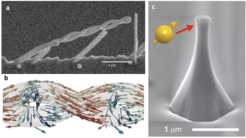Imaging 3D spin textures with a quantum sensor
When magnets are brought to the third dimension, they provide a rich playground for fundamental physics [1]. The higher degrees of freedom available in 3D – and the new topologies and geometries that it makes possible – combine to produce many new effects, including exotic dynamic behaviours, and topological textures that occur on length scales of the order of nanometres [2,3].
However, to probe these 3D spin textures experimentally, we are currently limited to large scale facilities such as synchrotron light sources [4]. The ability to probe these systems using a table-top technique would not only allow us to make the most of the exciting potential of these spin systems, but would be directly applicable to a host of key challenges in condensed matter physics.

In this project we will explore three-dimensional spin systems using a state-of-the-art magnetometry technique based on a single spin nitrogen-vacancy centre. The nitrogen-vacancy (NV) center is an isolated quantum spin trapped in a diamond, of atomic size and with extreme (∼ 1 nT) sensitivity to magnetic field and high spatial resolution (50 nm) [5,6]. As it is a single spin, it represents a non-invasive probe, a key advantage for the investigation of spin textures. Furthermore, quantum spin techniques can be used to probe both static configurations and dynamic fluctuations, and across a wide temperature range.
There will be two sides to this project: first, you will become an expert in the novel technique of NV magnetometry, and secondly, you will make key advances in our understanding of 3D spin systems.












